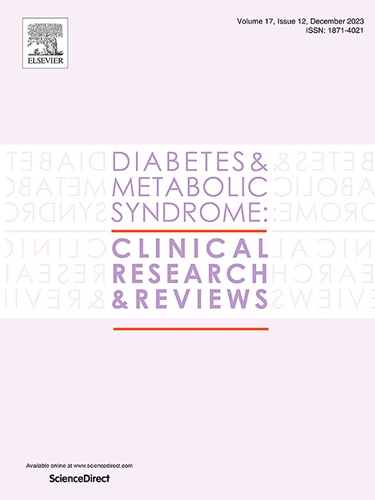我们如何才能最好地支持2型糖尿病患者的胰岛素自我滴定:一项系统综述和网络荟萃分析
IF 3.4
Q1 ENDOCRINOLOGY & METABOLISM
Diabetes & Metabolic Syndrome-Clinical Research & Reviews
Pub Date : 2025-03-01
DOI:10.1016/j.dsx.2025.103221
引用次数: 0
摘要
胰岛素自我滴定治疗2型糖尿病(T2D)的疗效因支持策略而异。本研究旨在确定不同胰岛素自我滴定支持策略对t2dm患者的影响。方法检索spubmed、EMBASE、CENTRAL和EBSCO自建校至2023年1月的开放论文。随机对照试验(RCTs)中t2dm患者报告HbA1c降低胰岛素自我滴定支持。干预措施按剂量指导(DG)、非剂量指导(NDG)和授权(empowerment)三部分进行分类。使用随机效应模型,汇总估计以95%置信区间(CI)的平均差异(md)和风险比(rr)表示。利用CINeMA在线平台评估证据的确定性。结果纳入17项随机对照试验(rct),共13528名受试者。与常规护理(UC)相比,接受剂量指导/授权的患者HbA1c降低幅度最大(MD - 1.20;95% CI:−2.33,−0.07),证据确定性中等。与常规护理相比,其他支持策略的HbA1c降低幅度较小,MD [95% CI]如下:非剂量指导/赋权组为- 0.97[- 1.24,- 0.69],剂量指导组为- 0.42[- 0.60,- 0.24],非剂量指导组为- 0.31[- 0.58,- 0.03]。严重低血糖的风险在各支持策略间无显著差异,确定性极低。结论将患者授权纳入胰岛素自我滴定支持策略,无论是剂量指导还是非剂量指导,都能更有效地降低HbA1c。本文章由计算机程序翻译,如有差异,请以英文原文为准。
How can we best support insulin self-titration in type 2 diabetes patients: A systematic review and network meta-analysis
Introduction
The efficacy of insulin self-titration in type 2 diabetes (T2D) varies by support strategy. This study aimed to identify the effects of different insulin self-titration support strategies in patients with T2D.
Methods
PubMed, EMBASE, CENTRAL, and EBSCO Open Dissertations were searched from inception to January 2023. Randomized controlled trials (RCTs) on T2D patients that reported HbA1c reduction of insulin self-titration supports were included. The interventions were classified based on the following components: dosage guidance (DG), non-dosage guidance (NDG) and empowerment. The pooled estimates were presented as mean differences (MDs) and risk ratios (RRs) with 95 % confidence interval (CI) using a random-effects model. The certainty of evidence was evaluated utilizing the CINeMA online platform.
Results
Seventeen RCTs (13,528 participants) were included. Compared with usual care (UC), the greatest reduction in HbA1c was observed in patients receiving dosage guidance/Empowerment (MD −1.20; 95 %CI: −2.33,−0.07), with moderate certainty of evidence. Lesser HbA1c reduction, MD [95 % CI], were observed in other support strategies when compared with usual care as follows: −0.97 [−1.24,−0.69] in non-dosage guidance/Empowerment, −0.42 [−0.60,−0.24] in dosage guidance, and −0.31 [−0.58,−0.03] in non-dosage guidance. The risk of severe hypoglycemia was not significantly difference among all support strategies, with very low certainty.
Conclusions
Incorporating patient empowerment into insulin self-titration support strategy, either dosage or non-dosage guidance, is more effective in lowering HbA1c.
求助全文
通过发布文献求助,成功后即可免费获取论文全文。
去求助
来源期刊

Diabetes & Metabolic Syndrome-Clinical Research & Reviews
ENDOCRINOLOGY & METABOLISM-
CiteScore
22.90
自引率
2.00%
发文量
248
审稿时长
51 days
期刊介绍:
Diabetes and Metabolic Syndrome: Clinical Research and Reviews is the official journal of DiabetesIndia. It aims to provide a global platform for healthcare professionals, diabetes educators, and other stakeholders to submit their research on diabetes care.
Types of Publications:
Diabetes and Metabolic Syndrome: Clinical Research and Reviews publishes peer-reviewed original articles, reviews, short communications, case reports, letters to the Editor, and expert comments. Reviews and mini-reviews are particularly welcomed for areas within endocrinology undergoing rapid changes.
 求助内容:
求助内容: 应助结果提醒方式:
应助结果提醒方式:


